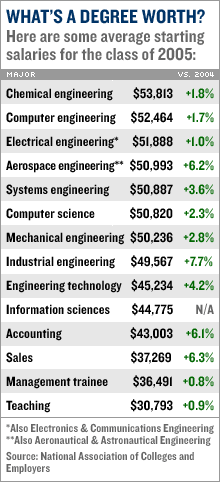Saturday, December 17, 2005
Is Time Travel almost Here?
 |
 |  |
by Clifford Pickover What is time? Is time travel possible? For centuries, these questions have intrigued mystics, philosophers, and scientists. Much of ancient Greek philosophy was concerned with understanding the concept of eternity, and the subject of time is central to all the world's religions and cultures. Can the flow of time be stopped? Certainly some mystics thought so. Angelus Silesius, a sixth-century philosopher and poet, thought the flow of time could be suspended by mental powers: Time is of your own making;The line between science and mysticism sometimes grows thin. Today physicists would agree that time is one of the strangest properties of our universe. In fact, there is a story circulating among scientists of an immigrant to America who has lost his watch. He walks up to a man on a New York street and asks, "Please, Sir, what is time?" The scientist replies, "I'm sorry, you'll have to ask a philosopher. I'm just a physicist." Most cultures have a grammar with past and future tenses, and also demarcations like seconds and minutes, and yesterday and tomorrow. Yet we cannot say exactly what time is. Although the study of time became scientific during the time of Galileo and Newton, a comprehensive explanation was given only in this century by Einstein, who declared, in effect, time is simply what a clock reads. The clock can be the rotation of a planet, sand falling in an hourglass, a heartbeat, or vibrations of a cesium atom. A typical grandfather clock follows the simple Newtonian law that states that the velocity of a body not subject to external forces remains constant. This means that clock hands travel equal distances in equal times. While this kind of clock is useful for everyday life, modern science finds that time can be warped in various ways, like clay in the hands of a cosmic sculptor.
One of the earliest methods for fictional time travel didn't involve a machine; the main character in Washington Irving's "Rip van Winkle" (1819) simply fell asleep for decades. King Arthur's daughter Gweneth slept for 500 years under Merlin's spell. Ancient legends of time distortion are, in fact, quite common. One of the most poetic descriptions of time travel occurs in a popular medieval legend describing a monk entranced for a minute by the song of a magical bird. When the bird stops singing, the monk discovers that several hundred years have passed. Another example is the Moslem legend of Muhammad carried by a mare into heaven. After a long visit, the prophet returns to Earth just in time to catch a jar of water the horse had kicked over before starting its ascent. Time travel is possible Today, we know that time travel need not be confined to myths, science fiction, Hollywood movies, or even speculation by theoretical physicists. Time travel is possible. For example, an object traveling at high speeds ages more slowly than a stationary object. This means that if you were to travel into outer space and return, moving close to light speed, you could travel thousands of years into the Earth's future. Newton's most important contribution to science was his mathematical definition of how motion changes with time. He showed that the force causing apples to fall is the same force that drives planetary motions and produces tides. However, Newton was puzzled by the fact that gravity seemed to operate instantaneously at a distance. He admitted he could only describe it without understanding how it worked. Not until Einstein's general theory of relativity was gravity changed from a "force" to the movement of matter along the shortest space in a curved spacetime. The Sun bends spacetime, and spacetime tells planets how to move. For Newton, both space and time were absolute. Space was a fixed, infinite, unmoving metric against which absolute motions could be measured. Newton also believed the universe was pervaded by a single absolute time that could be symbolized by an imaginary clock off somewhere in space. Einstein changed all this with his relativity theories, and once wrote, "Newton, forgive me."
We are a moment in astronomic time, a transient guest of the Earth. Our wet, wrinkled brains do not allow us to comprehend many mysteries of time and space. Our brains evolved to make us run from saber-toothed cats on the American savanna, to hunt deer, and to efficiently scavenge from the kills of large carnivores. Despite our mental limitations, we have come remarkably far. We have managed to pull back the cosmic curtains a crack to let in the light. Questions raised by physicists, from Newton to Kurt Gödel to Einstein to Stephen Hawking, are among the most profound we can ask. Is time real? Does it flow in one direction only? Does it have a beginning or an end? What is eternity? None of these questions can be answered to scientists' satisfaction. Yet the mere asking of these questions stretches our minds, and the continual search for answers provides useful insights along the way. Continue: The future of time travel |
Sunday, October 23, 2005
PeerGuardian 2 Gone :( No longer Can trust ?
read more | digg story
Tuesday, October 18, 2005
The Wave of the Future
Whats Next ? A semi-Submerged Home
Trilobis 65 Floating Home See Popular Mechanics November 2002 Article below
Trilobis 65 is a semi-submerged dwelling environment. Reaching 20 metres in length designed by Giancarlo Zema for habitation by six people at sea. It is ideal for living in bays, atolls and maritime parks. The main aim of the project is to allow anyone to live in a unique environment through a self sufficient, non-polluting dwelling cell in unison with their ocean surroundings.
|
|
|
Life, say the experts, began in the sea. And if the way we spend our vacations is an accurate indicator, there are few things we enjoy more than revisiting our submerged roots. Cavorting with dolphins, badgering sharks from the safety of steel cages and photographing exotic fish through the portholes of tourist submarines fascinates landlubbers from Prague to Peoria. For those who find these forays into Neptune's realm too brief, Italian naval architect Giancarlo Zema has the perfect dream home, the Trilobis 65. Part yacht and part submarine, it could convince Capt. Nemo to hang a "for sale" sign on the Nautilus. "The main aim of the project is to allow anyone to live in a unique environment through a self-sufficient, nonpolluting dwelling that exists in unison with their ocean surrounding," Zema tells POPULAR MECHANICS. At first glance, the Trilobis looks as if it would be more at home soaring into the sky than plying the waters of atolls, bays and maritime parks. Looking at a computer image of the bow conjures up visions of the flying saucers in 1950s science fiction films. The Trilobis's blueprints, however, reveal a nautical heritage that reaches back to the humble dugout while simultaneously embracing 21st century technologies that include high-strength composites and nonpolluting hydrogen fuels. |

Circular Living - Perhaps the most striking feature of Zema's design is one that reflects his willing recognition of the great unspoken truth about luxury yachts. Powerful engines and sleek hulls aside, these vessels typically stick close to home. Acknowledging the fact that well-heeled mariners often prefer to keep their floating palaces moored inches from the dock, Zema also designed a special type of marina that will enable like-minded Trilobis owners to create their own floating villages. The traditional rectangular dock will disappear, to be replaced by a roughly 60-ft.-dia. circular island in the shape of a 6-tooth gear, into which individual yachts fit like pieces of a jigsaw puzzle.Stepping off the floating island, yachtsmen will ascend a few steps and find themselves on an expansive circular deck. At this level, the Trilobis resembles a deviled egg, measuring about 65 ft. from stem to stern and 42 ft. from port to starboard. Zema has divided the interior space into four functionally different levels, connected by a spiral stairway that runs through the yacht's centerline. The top of the stairway opens onto the driving deck. Housing the helm, communications equipment and navigation gear, it offers the best view of the sea from its elevation of about 11 ft. above the waterline. The space is dominated by a massive glass wall that begins above the stairway and arcs gently over the forward seating area before disappearing into the deck below. Ordinarily, so large an expanse of glass would pose a heating problem, but this is no ordinary window. It is a sandwich of two layers of tempered glass and an electrolyte with a very unusual property. With the turn of a dial, you can change the voltage flowing through the electrolyte material, which is encased between the panes, altering the tint of the window or blacking it out entirely. Power for the windows and the ship's electrical systems comes from photovoltaic panels, manufactured by Siemens, that are integrated into a foam-reinforced fiberglass skin. At night and on cloudy days, power comes from batteries, with an inverter converting DC into AC for low-loss power distribution. |

Day And Night - Descending from the top to the craft's third level, yachtsmen will enter what Zema calls the day area. Its use of space is a reminder that spherical structures are more efficient than rectangular ones. As with the space above it, the day area is surrounded by self-shading glass, offering a panoramic view from the gourmet kitchen, formal dining area and three seating groups. On this level, the spiral stairway serves a secondary function of separating interior and exterior spaces. Sliding glass doors fully retract, opening onto a teak deck.Returning inside and following the stairway down one more flight leads to what is known as the night zone. The Trilobis sleeps six, with a premium on privacy. The design calls for two single and two double bedrooms, each with a private bathroom. With the deck at this level beginning 3 ft. below the waterline, the wraparound window cuts off at eye level.This level also houses the yacht's propulsion system, which consists of two electric motors. Each is rated at about 300 hp. They are powered by hydrogen-fed Ballard fuel cells. The hydrogen for the fuel cells will be stored in a pair of 240-gal. tanks located just aft of the single bedrooms. The fuel supply is not intended for ocean crossings, but to be sufficient for moving the yacht to nearby reefs to explore seasonal changes in marine life and catch a true fish-eyes view of unusual migrating species. |

Ocean Depths - The most distinctive feature of the Trilobis is its fully submerged first level, the observation bulb. Like the driving deck and day area above, it offers a commanding and unobstructed view of the sea. Only here, that view begins 10 ft. below the waterline. This is the smallest of the levels, just big enough for six chairs. Built to the same technical standards as tourist submarines, it is a thick glass enclosure that provides a 360° view. So that this area can be used when there's no sunlight, the Trilobis has a ring of 200-watt spotlights, angled away from the observation bulb, to illuminate any sea life swimming directly in front of the viewers. The second set of spotlights, placed just below the deck level, lights the reefs below. Zema is several years from building the first Trilobis. Most likely, it will be constructed in Vancouver, British Columbia, where he has set up an exclusive marketing relationship with Underwater Vehicles Inc. The location may seem like an unusual choice, but the region has the two essential ingredients needed to make the Trilobis project a success. The first is its wealth of small inlets and bays. The second is a pool of wealthy yacht owners, one of whom may be willing to invest the $4 million to $5 million it will take to launch yachting into the 21st century. Contact Underwater Vehicles Inc. at www.sub-find.com. |

Wednesday, October 12, 2005
New NBA Disscussion

NBA
Round Table Talk
→
Discussion

NBA-Basketball Talk- Lets Talk Hoops.
We can talk about anything
Basketball related here from Nba Current/past News to fantasy Basketball.
Thursday, September 22, 2005
The Wave of the Future
Trilobis 65 is a semi-submerged
dwelling environment. Reaching 20 metres in length designed by
Giancarlo Zema for habitation by six people at sea. It is ideal for living in bays, atolls and maritime parks. The main aim of the project is to allow anyone to live in a unique environment through a self sufficient, non-polluting dwelling cell in unison with their ocean surroundings.
Trilobis 65 has been designed on four separate levels connected by a spiraling staircase.
The top level is 3.5 metres above
sea level. The next level is at 1.4 metres above sea level and hosts the daylight zone with all services and allowing outdoor access. The third level is situated at 0.8 metre below sea level, semi-submerged, and is devoted to the night-time zone. At 3.0 metres below sea level, totally submerged, there is the underwater observation bulb, an intimate and mediative place.
The shape of Trilobis 65 allows the annular aggregation of more
modular units, creating island colonies.
This special project refers to the Trilobiti, little creatures that lived in the sea 500 milion years ago.
Contact Underwater Vehicles Inc. for further details regarding custom floating homes and Neptus 60 cliff-side dwellings with underwater viewing compartments. All homes are engineered to meet strict ABS and Lloyds certification requirements.
Maximum length - 20 mt
Maximum width - 13 mt
Observation bulb - 3 mt o.s.l. Max Speed - 7 knots
Accommodation - 6 beds
Power source options - Ballard fuel cells, solar, wind, diesel
New - from Giancarlo Zema
Lake Washington Commercial and Recreational Marine Park





Monday, September 19, 2005
If Microsoft does buy AOL…
Wednesday, September 14, 2005
College Majors That Pay Out the Most
read more digg story
 | |
NEW YORK (CNN/Money) - Knowing history is important, lest you repeat it. And everyone appreciates a film major when discussing directors over dinner.
But when it's time to switch from paying tuition to collecting a paycheck, nothing will lock down a starting salary like these three majors: Engineering, engineering and engineering.
Actually, make that seven engineerings.
Some type of applied science degrees make up seven of the top ten majors that receive the highest starting salary, according to the National Association of Colleges & Employers' (NACE) summer 2005 salary survey.
Chemical engineering was the highest paid major, with an average starting salary of $53,813, followed by computer engineering at $52,464 and electrical engineering at $51,888.
The rest of the list, in descending order, is aerospace engineering, systems engineering, computer science, mechanical engineering, industrial engineering, engineering technology and information sciences and systems.
And those salaries are going up too.
Tuesday, September 13, 2005
The Latest
| NEWS CATEGORIES |
| ||||||||||||||||||||||||||||||||||||||||||||||||||||||||||||||||||









 Most popular by reads
Most popular by reads

 Most popular by rating
Most popular by rating

















